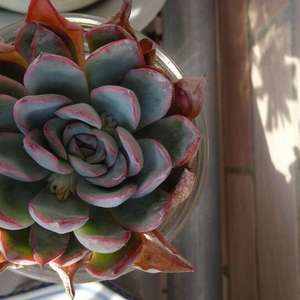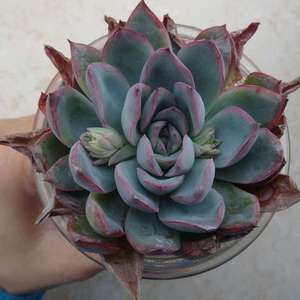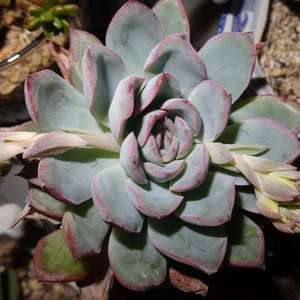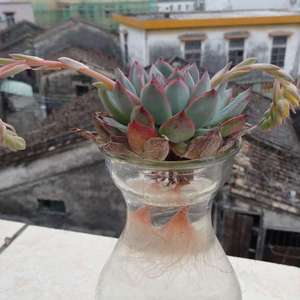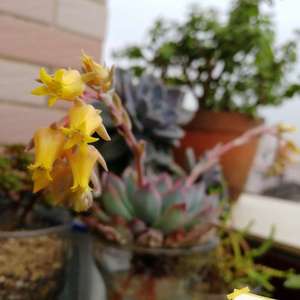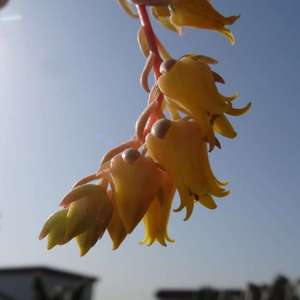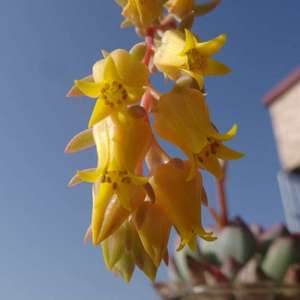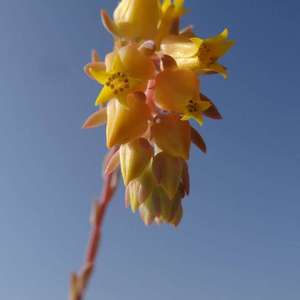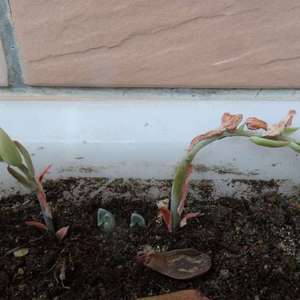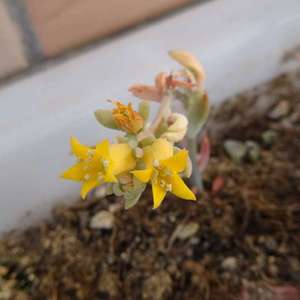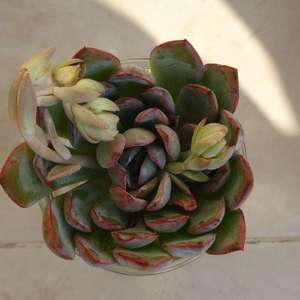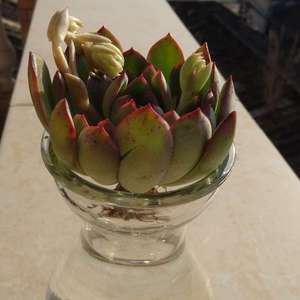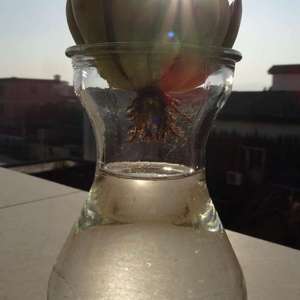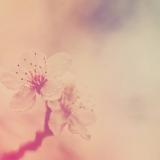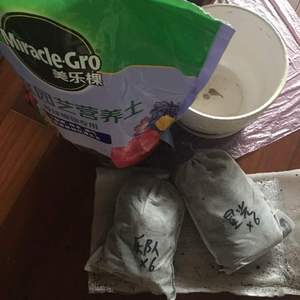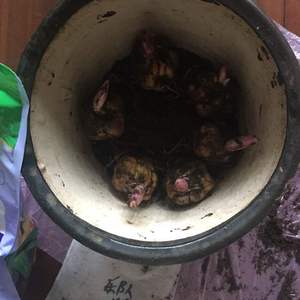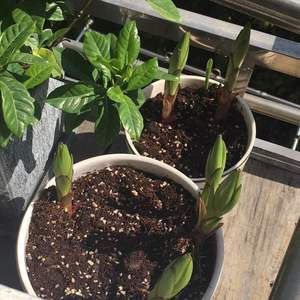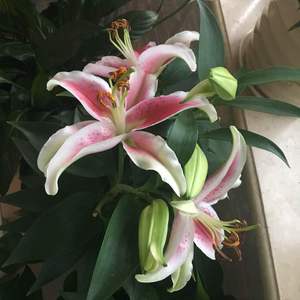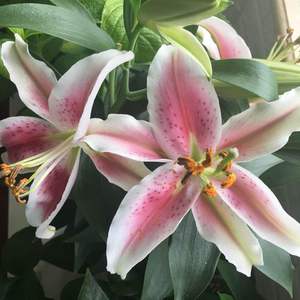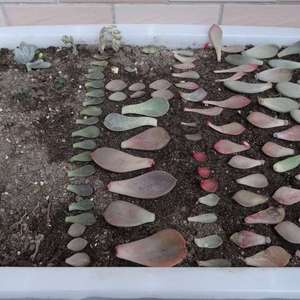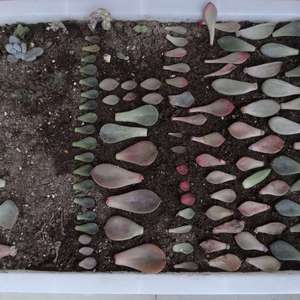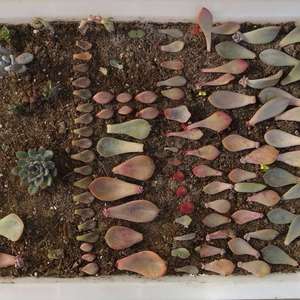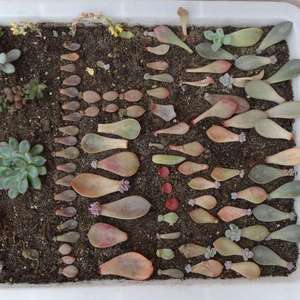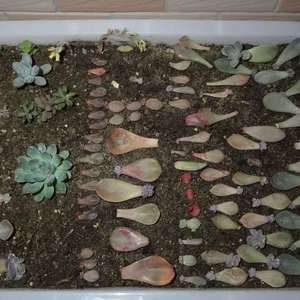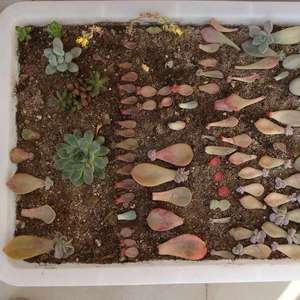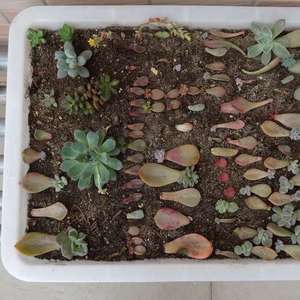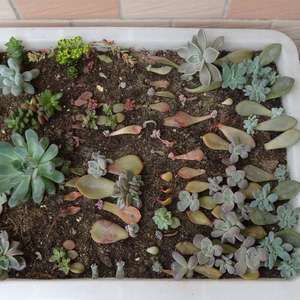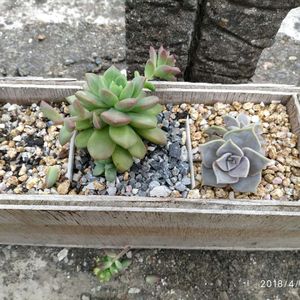文章
Miss Chen
2018年06月08日

Description: This annual plant is ½–3' tall, branching sparingly. The central stem is glabrous and occasionally angular. The opposite leaves are up to 5" long and 1" across, although usually smaller in size. They are linear-oblong to lanceolate-ovate, serrated along the margins, and hairless. These leaves are never lobed nor pinnately compound. At the base, the pairs of opposite leaves clasp the stem and nearly surround it (i.e., they're nearly connate), or they are sessile. The upper stems terminate in flowerheads about ½–1½" across. These flowerheads have a tendency to nod downward with age and the central head of disk florets becomes larger and more rounded. The corolla of each disk floret is yellow and narrowly tubular with 5 lobes. There are about 8 ray florets surrounding the disk florets, but sometimes they lack petaloid rays. When they are present, the petaloid rays are bright yellow and oblong-elliptic in shape; they are variable in length, depending on the local ecotype.
At the base of each flowerhead, there are both inner and outer bracts (phyllaries). The inner bracts are pale yellow, membranous along their margins, and rather broad, tapering to blunt tips. The outer bracts are green and oblong-linear. These latter bracts are about as long or longer than the petaloid rays, but they have a tendency to curl backward with age. There are about 6-10 outer bracts per flowerhead. The blooming period occurs from late summer to early fall and lasts about 1-2 months for a colony of plants. Each achene is oblongoid, although broader and somewhat truncated at its apex, where there are usually 4 barbed awns. The root system is shallow and branches frequently. This plant often forms colonies and spreads by reseeding itself; sometimes the lower portion of a stem will form rootlets at the leaf nodes when it lies against moist soil. Nodding Bur-Marigold is rather variable across its range. The leaves have a tendency to turn purple during the cool weather of autumn.

Cultivation: The preference is full or partial sun, wet conditions, and mucky soil. Occasional flooding is readily tolerated, although this species is not an emergent aquatic. Sometimes the leaves succumb to powdery mildew during the fall. This plant is less tolerant of dry conditions than other Bidens spp.
Range & Habitat: The native Nodding Bur-Marigold is common in central and northern Illinois, but occasional to absent in southern Illinois (see Distribution Map). Habitats include swamps, bogs, seeps, marshes, edges of rivers and ponds, soggy meadows in floodplain areas, and ditches along roads and railroads. Nodding Bur-Marigold is often found in degraded wetlands, although it also occurs in higher quality wetlands.

Faunal Associations: Plants with showier flowers attract an abundance of bees, wasps, butterflies, skippers, moths, and various kinds of flies. Bee visitors include honey bees, bumblebees, long-horned bees (Melissodes spp.), leaf-cutting bees (Megachile spp.), and plasterer bees (Colletes spp.). These insects suck nectar from the flowers; bees also collect pollen. The caterpillars of the butterfly Nathalis iole (Dainty Sulfur) feed on the foliage. The caterpillars of several species of moths also feed on Bidens spp., including Epiblema otiosana (Bidens Borer Moth), Cirrhophanus triangulifer (Goldenrod Stowaway), Condica mobilis (Mobile Groundling), and Condica confederata (The Confederate). Other insect feeders the leaf beetles Calligrapha bidenticola and Calligrapha californica, the fruit fly Icterica seriata, and several aphid species.

To a limited extent, the seeds of Bidens spp. are eaten by various kinds of birds, including the Mallard Duck, Swamp Sparrow, Purple Finch, and Common Redpoll (the latter during the winter). The foliage is occasionally eaten by the Cottontail Rabbit. The seeds of Bidens spp. are notorious for their ability to cling to the fur of animals, the feathers of birds, or the clothing of humans, by which means they are distributed far and wide.
Photographic Location: Along a drainage canal in Champaign, Illinois.

Comments: The attractiveness of the flowers is variable, depending upon the length of the petaloid rays, which are not always present. It is fairly easy to distinguish Nodding Bur-Marigold from other Bidens spp. because of its undivided leaves and achenes with 4 awns (rarely fewer). Plants with flowerheads that are large and showy can resemble Bidens laevis (Smooth Bur-Marigold), but this latter species doesn't occur in Illinois. The petaloid rays of Smooth Bur-Marigold are at least as long as the outer floral bracts (phyllaries) and it usually has showier flowers. When the flowerheads of Nodding Bur-Marigold lack petaloid rays, this species can be confused with Bidens connata (Purple-Stemmed Beggar's Tick) and Bidens comosa (Swamp Beggar's Tick). Nodding Bur-Marigold differs from these latter species by its leaves, which are sessile or they clasp and nearly surround the stem. Purple-Stemmed Beggar's Tick and Swamp Beggar's Tick have leaves with distinct petioles that are winged or unwinged. The flowerheads of Nodding Bur-Marigold nod downward with age, while the flowerheads of the latter two species usually remain more erect.
At the base of each flowerhead, there are both inner and outer bracts (phyllaries). The inner bracts are pale yellow, membranous along their margins, and rather broad, tapering to blunt tips. The outer bracts are green and oblong-linear. These latter bracts are about as long or longer than the petaloid rays, but they have a tendency to curl backward with age. There are about 6-10 outer bracts per flowerhead. The blooming period occurs from late summer to early fall and lasts about 1-2 months for a colony of plants. Each achene is oblongoid, although broader and somewhat truncated at its apex, where there are usually 4 barbed awns. The root system is shallow and branches frequently. This plant often forms colonies and spreads by reseeding itself; sometimes the lower portion of a stem will form rootlets at the leaf nodes when it lies against moist soil. Nodding Bur-Marigold is rather variable across its range. The leaves have a tendency to turn purple during the cool weather of autumn.

Cultivation: The preference is full or partial sun, wet conditions, and mucky soil. Occasional flooding is readily tolerated, although this species is not an emergent aquatic. Sometimes the leaves succumb to powdery mildew during the fall. This plant is less tolerant of dry conditions than other Bidens spp.
Range & Habitat: The native Nodding Bur-Marigold is common in central and northern Illinois, but occasional to absent in southern Illinois (see Distribution Map). Habitats include swamps, bogs, seeps, marshes, edges of rivers and ponds, soggy meadows in floodplain areas, and ditches along roads and railroads. Nodding Bur-Marigold is often found in degraded wetlands, although it also occurs in higher quality wetlands.

Faunal Associations: Plants with showier flowers attract an abundance of bees, wasps, butterflies, skippers, moths, and various kinds of flies. Bee visitors include honey bees, bumblebees, long-horned bees (Melissodes spp.), leaf-cutting bees (Megachile spp.), and plasterer bees (Colletes spp.). These insects suck nectar from the flowers; bees also collect pollen. The caterpillars of the butterfly Nathalis iole (Dainty Sulfur) feed on the foliage. The caterpillars of several species of moths also feed on Bidens spp., including Epiblema otiosana (Bidens Borer Moth), Cirrhophanus triangulifer (Goldenrod Stowaway), Condica mobilis (Mobile Groundling), and Condica confederata (The Confederate). Other insect feeders the leaf beetles Calligrapha bidenticola and Calligrapha californica, the fruit fly Icterica seriata, and several aphid species.

To a limited extent, the seeds of Bidens spp. are eaten by various kinds of birds, including the Mallard Duck, Swamp Sparrow, Purple Finch, and Common Redpoll (the latter during the winter). The foliage is occasionally eaten by the Cottontail Rabbit. The seeds of Bidens spp. are notorious for their ability to cling to the fur of animals, the feathers of birds, or the clothing of humans, by which means they are distributed far and wide.
Photographic Location: Along a drainage canal in Champaign, Illinois.

Comments: The attractiveness of the flowers is variable, depending upon the length of the petaloid rays, which are not always present. It is fairly easy to distinguish Nodding Bur-Marigold from other Bidens spp. because of its undivided leaves and achenes with 4 awns (rarely fewer). Plants with flowerheads that are large and showy can resemble Bidens laevis (Smooth Bur-Marigold), but this latter species doesn't occur in Illinois. The petaloid rays of Smooth Bur-Marigold are at least as long as the outer floral bracts (phyllaries) and it usually has showier flowers. When the flowerheads of Nodding Bur-Marigold lack petaloid rays, this species can be confused with Bidens connata (Purple-Stemmed Beggar's Tick) and Bidens comosa (Swamp Beggar's Tick). Nodding Bur-Marigold differs from these latter species by its leaves, which are sessile or they clasp and nearly surround the stem. Purple-Stemmed Beggar's Tick and Swamp Beggar's Tick have leaves with distinct petioles that are winged or unwinged. The flowerheads of Nodding Bur-Marigold nod downward with age, while the flowerheads of the latter two species usually remain more erect.
0
0
文章
Miss Chen
2018年06月08日

Description: This perennial wildflower is 3-8' tall, branching sparingly. The large hollow stems are pale purple to dark purple, terete, glabrous, and often glaucous. Alternate compound leaves occur along the stems, primarily along the lower-half of each plant. The compound leaves are ½-2' long, ½-2' across, and widest at their bases. The structure of the compound leaves is bipinnate with 3-5 leaflets or subleaflets per division. The subleaflets are ¾-4½" long and ½-2½" across; they are more or less ovate in shape and their margins are serrated. Some subleaflets are shallowly to deeply cleft into lobes. The upper surface of the subleaflets is medium to dark green and glabrous, while the lower surface is pale or whitish green and glabrous. The subleaflets are either sessile or they have short petioles; they often have winged extensions at their bases that join the branches of the rachis. The petioles are long, stout, and conspicuously sheathed at their bases; both the petioles and their sheaths are green to light purple to dark purple, glabrous, and often glaucous.
The upper stems terminate in one or more compound umbels of flowers spanning 3-9" across; they are globoid in shape. Sometimes the peduncle of a compound umbel will branch and terminate in another compound umbel. Each compound umbel has 15-40 rays (floral branches) that terminate in small umbellets. Each umbellet has numerous greenish white to pale yellow flowers on pedicels about ½" in length. Each flower is up to ¼" across, consisting of 5 petals with incurved tips, a light green calyx without significant lobes, 5 stamens, and a pistil with a divided style. The blooming period occurs from late spring to early summer and lasts about 3 weeks. Afterwards, the flowers are replaced by dry seed-like fruits (consisting of double achenes). The fruits are 5-8 mm. in length, oblongoid-ovoid in shape, and slightly flattened; each side of the fruit has 3 longitudinal ridges. Immature fruits are greenish yellow, turning brown at maturity. Each achene has a pair of lateral wings along its main body; it is convex and ridged on one side, while the other side is flat. The root system consists of a short stout taproot.
Cultivation: The preference is full or partial sun, consistently wet to moist conditions, and loamy or sandy soil with decaying organic matter. Soil pH should be mildly acidic to alkaline. Standing water is well-tolerated. Individual plants can vary considerably in size depending on environmental conditions.

Range & Habitat: The native Great Angelica is occasional in northern Illinois, while in the rest of the state it is uncommon or absent (see Distribution Map). Habitats include openings in bottomland woodlands, swamps, soggy thickets, edges of woodlands adjoining wetlands, marshes, fens, and seeps, including the lower slopes of hillside seeps. This robust wildflower is typically found in calcareous habitats with a stable supply of moisture.
Faunal Associations: The flowers attract Syrphid flies, bee flies, Andrenid bees, and other small bees. These visitors are attracted primarily to the nectar of the flowers. A relatively small number of insects are known to feed on Great Angelica. These species include the aphids Aphis thaspii and Cavariella konoi, caterpillars of Papaipema birdi (Umbellifer Borer Moth) and Papaipema harrisii (Cow Parsnip Borer Moth), and caterpillars of the butterfly Papilio polyxenes asterius (Black Swallowtail).

Photographic Location: A woodland border near a fen at the Indiana Dunes National Lakeshore in NW Indiana.
Comments: Great Angelica can be distinguished from similar species in the Carrot family by its large size, hollow purplish stems, and spherical compound umbels. Sometimes an aromatic Eurasia species, Angelica archangelica (Garden Angelica), is cultivated in gardens. It differs from Great Angelica by its biennial habit and greenish stems. So far, there are no records of Garden Angelica naturalizing in Illinois. A native perennial species, Angelica venenosa (Wood Angelica), is found in southern Illinois, where it occurs in dry rocky habitats. Wood Angelica has more narrow sheaths at the bases of its petioles than Great Angelica, and their are fine hairs on its fruits. Another common name of Angelica atropurpurea is Purple-Stemmed Angelica.
The upper stems terminate in one or more compound umbels of flowers spanning 3-9" across; they are globoid in shape. Sometimes the peduncle of a compound umbel will branch and terminate in another compound umbel. Each compound umbel has 15-40 rays (floral branches) that terminate in small umbellets. Each umbellet has numerous greenish white to pale yellow flowers on pedicels about ½" in length. Each flower is up to ¼" across, consisting of 5 petals with incurved tips, a light green calyx without significant lobes, 5 stamens, and a pistil with a divided style. The blooming period occurs from late spring to early summer and lasts about 3 weeks. Afterwards, the flowers are replaced by dry seed-like fruits (consisting of double achenes). The fruits are 5-8 mm. in length, oblongoid-ovoid in shape, and slightly flattened; each side of the fruit has 3 longitudinal ridges. Immature fruits are greenish yellow, turning brown at maturity. Each achene has a pair of lateral wings along its main body; it is convex and ridged on one side, while the other side is flat. The root system consists of a short stout taproot.
Cultivation: The preference is full or partial sun, consistently wet to moist conditions, and loamy or sandy soil with decaying organic matter. Soil pH should be mildly acidic to alkaline. Standing water is well-tolerated. Individual plants can vary considerably in size depending on environmental conditions.

Range & Habitat: The native Great Angelica is occasional in northern Illinois, while in the rest of the state it is uncommon or absent (see Distribution Map). Habitats include openings in bottomland woodlands, swamps, soggy thickets, edges of woodlands adjoining wetlands, marshes, fens, and seeps, including the lower slopes of hillside seeps. This robust wildflower is typically found in calcareous habitats with a stable supply of moisture.
Faunal Associations: The flowers attract Syrphid flies, bee flies, Andrenid bees, and other small bees. These visitors are attracted primarily to the nectar of the flowers. A relatively small number of insects are known to feed on Great Angelica. These species include the aphids Aphis thaspii and Cavariella konoi, caterpillars of Papaipema birdi (Umbellifer Borer Moth) and Papaipema harrisii (Cow Parsnip Borer Moth), and caterpillars of the butterfly Papilio polyxenes asterius (Black Swallowtail).

Photographic Location: A woodland border near a fen at the Indiana Dunes National Lakeshore in NW Indiana.
Comments: Great Angelica can be distinguished from similar species in the Carrot family by its large size, hollow purplish stems, and spherical compound umbels. Sometimes an aromatic Eurasia species, Angelica archangelica (Garden Angelica), is cultivated in gardens. It differs from Great Angelica by its biennial habit and greenish stems. So far, there are no records of Garden Angelica naturalizing in Illinois. A native perennial species, Angelica venenosa (Wood Angelica), is found in southern Illinois, where it occurs in dry rocky habitats. Wood Angelica has more narrow sheaths at the bases of its petioles than Great Angelica, and their are fine hairs on its fruits. Another common name of Angelica atropurpurea is Purple-Stemmed Angelica.
0
0
文章
Miss Chen
2018年06月08日

Description: This perennial plant is 1–3½' tall, consisting of tufts of basal leaves that emerge directly from a spreading rootstock. These basal leaves are erect and sword-shaped, resembling the basal leaves of Iris spp. (Irises), but more green. They are flattened (on one side more than the other), smooth along the margins, and have parallel veins. There is often an off-center ridge/indentation along the length of each leaf. Sometimes the base of the leaves or their margins are slightly red. Some leaves develop a cylindrical spadix that is about 2–4" in length and semi-erect. This spadix is covered with tiny greenish yellow flowers in a diamond-shaped pattern. Each flower has 6 tepals and 6 stamens. The spathe is regarded as absent by some authorities, while others consider the spathe to be a bract-like extension of the basal leaf. The blooming period occurs from late spring to early summer and lasts about a month. Both the crushed foliage and rootstocks have a pleasant aromatic fragrance. Because Sweet Flag is a sterile polyploid species, it doesn't produce any fruit with fertile seeds. The root system consists of shallow branching rhizomes that are stout and knobby; they have a brown exterior and white interior. Tufts of basal leaves occur at intervals along these rhizomes, while coarse fibrous roots develop below. This plant spreads vegetatively by its rhizomes and often forms colonies.
Cultivation: The preference is full or partial sun and wet mucky ground or shallow water along shores. This species is semi-aquatic. It is fairly easy to establish from pieces of the rhizome.
Range & Habitat: The non-native Sweet Flag occurs occasionally throughout Illinois, although it is less common or absent in the NW and southern areas of the state (see Distribution Map). It was introduced into North America for medicinal, ornamental, and other purposes. Sweet Flag is native to India, central Asia, and probably Eastern Europe. Habitats include sedge meadows that are prone to flooding, edges of small lakes and ponds, marshes, swamps, seeps and springs, and wetland restorations. Even though this is an introduced plant, it has been found in both high quality and degraded wetlands.
Faunal Associations: Muskrats are fond of the rootstocks and readily consume them. Otherwise, little information is available about floral-faunal relationships.
Photographic Location: Along the shore of a small lake at a city park in Champaign, Illinois.

Comments: The rootstocks of this aromatic plant are used as a natural insecticide and an ingredient of perfumes. They were used by Amerindians for various medicinal purposes, and reportedly induce hallucinations if eaten in sufficiently large quantities. These properties are primarily the result of Alpha-asarone and Beta-asarone; the latter has been found to be carcinogenic. As a consequence, the Food & Drug Administration (FDA) has banned the use of the rootstocks as a food additive. A similar species, Acorus americanus (American Sweet Flag), is restricted to the northern half of North America. It is virtually identical to Acorus calamus (Sweet Flag), except that it has several prominent veins along the length of each leaf. Sweet Flag has a single prominent vein on each leaf that is marked by an off-center ridge/indentation along its length. Another difference is that American Sweet Flag is a fertile diploid that produces fruit with viable seeds. In the past, this species was regarded as a variety of Sweet Flag, and it was referred to as Acorus calamus americanus. American Sweet Flag contains Alpha-asarone, but it lacks significant amounts of the carcinogenic Beta-asarone – therefore, it may be safer to use in the preparations that are described above. The Acorus spp. (Sweet Flags) were classified in the Araceae (Arum family) in the past, but they have been reclassified to their own family, the Acoraceae, as a result of recent chromosomal studies.
Cultivation: The preference is full or partial sun and wet mucky ground or shallow water along shores. This species is semi-aquatic. It is fairly easy to establish from pieces of the rhizome.
Range & Habitat: The non-native Sweet Flag occurs occasionally throughout Illinois, although it is less common or absent in the NW and southern areas of the state (see Distribution Map). It was introduced into North America for medicinal, ornamental, and other purposes. Sweet Flag is native to India, central Asia, and probably Eastern Europe. Habitats include sedge meadows that are prone to flooding, edges of small lakes and ponds, marshes, swamps, seeps and springs, and wetland restorations. Even though this is an introduced plant, it has been found in both high quality and degraded wetlands.
Faunal Associations: Muskrats are fond of the rootstocks and readily consume them. Otherwise, little information is available about floral-faunal relationships.
Photographic Location: Along the shore of a small lake at a city park in Champaign, Illinois.

Comments: The rootstocks of this aromatic plant are used as a natural insecticide and an ingredient of perfumes. They were used by Amerindians for various medicinal purposes, and reportedly induce hallucinations if eaten in sufficiently large quantities. These properties are primarily the result of Alpha-asarone and Beta-asarone; the latter has been found to be carcinogenic. As a consequence, the Food & Drug Administration (FDA) has banned the use of the rootstocks as a food additive. A similar species, Acorus americanus (American Sweet Flag), is restricted to the northern half of North America. It is virtually identical to Acorus calamus (Sweet Flag), except that it has several prominent veins along the length of each leaf. Sweet Flag has a single prominent vein on each leaf that is marked by an off-center ridge/indentation along its length. Another difference is that American Sweet Flag is a fertile diploid that produces fruit with viable seeds. In the past, this species was regarded as a variety of Sweet Flag, and it was referred to as Acorus calamus americanus. American Sweet Flag contains Alpha-asarone, but it lacks significant amounts of the carcinogenic Beta-asarone – therefore, it may be safer to use in the preparations that are described above. The Acorus spp. (Sweet Flags) were classified in the Araceae (Arum family) in the past, but they have been reclassified to their own family, the Acoraceae, as a result of recent chromosomal studies.
0
0
文章
Miss Chen
2018年06月07日

Description: This variety of Yellow Violet (Viola pubescens pubescens) forms 0-2 basal leaves from the rootstock during early to mid-spring. When they are present, the basal leaves are 1½-3" long and similarly across; they are oval-cordate or orbicular-cordate in shape and their margins are crenate-serrate. The upper surfaces of basal leaves are medium green and glabrous to sparsely short-pubescent, while their lower surfaces are light green and pubescent (especially along the major veins). The erect to ascending petioles of the basal leaves are are 2-5" long, light green, and pubescent. For this variety of Yellow Violet, only 1-2 leafy stems are produced per rootstalk. These stems are 4-10" long, light green, terete, and conspicuously pubescent; they are erect, ascending, or sprawling. Alternate leaves occur along each stem. These leaves are 2-4" long and 2-3½" across; they are ovate-cordate to oval-cordate in shape, while their margins are crenate-serrate and ciliate. The upper surfaces of alternate leaves are medium green, glabrous to sparsely short-pubescent, while their lower surfaces are light green and pubescent (especially along the major veins). The petioles of alternate leaves are ½-4" long, light green, and pubescent. At the petiole bases, there are pairs of leafy stipules about ¼-¾" long. The stipules are light green, lanceolate-oblong to lanceolate-ovate in shape, smooth (entire) or slightly toothed along their margins, and glabrous to pubescent.
Individual flowers are produced from the axils of alternate leaves. Each flower spans about ¾" across, consisting of 5 yellow petals, 5 light green sepals, 5 inserted stamens, and a pistil with an inserted style. Branched brownish purple veins occur along the lowest petal and, to a much lesser extent, the 2 lower lateral petals. At the bases of the 2 lower lateral petals, there are small tufts of hair. The lowest petal has a nectar spur that is short and blunt. The sepals are shorter than the petals, linear-lanceolate in shape, and glabrous. The slender pedicels of the flowers are 2-8" long, light green, pubescent, and ascending. The tips of the pedicels are curved, causing the flowers to nod partially. Toward the middle of each pedicel, there is a pair of tiny bractlets that are about 2 mm. long, light green, and linear-lanceolate in shape. The blooming period occurs from mid- to late spring, lasting about 1-1½ months. The flowers are often slightly fragrant. After the flowers with showy petals have finished blooming, cleistogamous flowers without petals are produced. Fertile flowers of both types are replaced by seed capsules about ½" long that are ovoid, bluntly 3-angled, and either glabrous orDistribution Map pubescent. Immature capsules are light green, but they later turn brown and split open into 3 parts, ejecting their seeds. The seeds are about 2.0-2.5 mm. long, ovoid-globoid in shape, slightly flattened, and tan-colored to brown. Each seed has a small oily appendage. The root system is rhizomatous and fibrous. The clonal plants are occasionally produced from the rhizomes.
Cultivation: The preference is partial sun to light shade, moist to dry-mesic conditions, and a relatively loose soil containing loam or sandy loam with some decaying organic matter (e.g., fallen leaves). This violet doesn't tolerate mowing. It is able to flourish in areas that have pine needles as ground litter to a greater extent than many other plants.
Range & Habitat: The native Hairy Yellow Violet (Viola pubescens pubescens) is occasional in northern Illinois, while in the rest of the state it is apparently absent. It is less common within the state than another variety of this species, Smooth Yellow Violet (Viola pubescens eriocarpa). Habitats include mesic to upland woodlands, sandy woodlands, forested sand dunes, and areas along woodland paths.
Faunal Associations: The flowers are cross-pollinated primarily by bees, including mason bees (Osmia spp.), little carpenter bees (Ceratina spp.), Anthophorid bees, Halictid bees, and Andrenid bees. Other insects that visit the flowers include bee flies (Bombylius major), small butterflies, and skippers. Bees suck nectar and collect pollen, while other floral visitors suck nectar. Some insects feed destructively on the foliage, plant juices, and other parts of violets (Viola spp.). These insect feeders include Neotoxoptera violae (Violet Aphid), Ametastegia pallipes (Violet Sawfly), Odontothrips pictipennis (a thrips), caterpillars of the moth Elaphria grata (Grateful Midget), and caterpillars of various Fritillary butterflies (Boloria spp., Speyeria spp.). Because of their oily appendages, the seeds are spread to new areas by ants. Among vertebrate animals, the seeds of violets are consumed by such birds as the Mourning Dove, Ruffed Grouse, Wild Turkey, and Slate-Colored Junco; and by such small rodents as the Pine Mouse and White-Footed Mouse (Martin et al., 1951/1961). The leaves and stems of these plants are eaten by the Cottontail Rabbit, Eastern Chipmunk, and Wood Turtle (Martin et al., 1951/1961; Wrazen & Svendsen, 1978; Ernst et al., 1994). White-Tailed Deer browse on the foliage very sparingly.

Photographic Location: A forested sand dune at the Indiana Dunes State Park in NW Indiana.
Comments: Because Hairy Yellow Violet (Viola pubescens pubescens) and Smooth Yellow Violet (Viola pubescens eriocarpa) intergrade, they are considered different varieties of the same species. Hairy Yellow Violet can be identified by the conspicuous pubescence on its stems, pedicels, and leaf undersides, while the stems, pedicels, and leaf undersides of Smooth Yellow Violet are slightly short-pubescent to nearly glabrous. Hairy Yellow Violet also differs from the latter variety by producing fewer basal leaves and leafy stems per rootstalk, and its stipules are usually larger in size and more rounded toward their tips. Plants with glabrous seed capsules have been classified as Viola pubescens peckii (Peck's Yellow Violet), but most botanists don't recognize this variety at the present time. Another common name of Viola pubescens pubescens is Downy Yellow Violet.
Individual flowers are produced from the axils of alternate leaves. Each flower spans about ¾" across, consisting of 5 yellow petals, 5 light green sepals, 5 inserted stamens, and a pistil with an inserted style. Branched brownish purple veins occur along the lowest petal and, to a much lesser extent, the 2 lower lateral petals. At the bases of the 2 lower lateral petals, there are small tufts of hair. The lowest petal has a nectar spur that is short and blunt. The sepals are shorter than the petals, linear-lanceolate in shape, and glabrous. The slender pedicels of the flowers are 2-8" long, light green, pubescent, and ascending. The tips of the pedicels are curved, causing the flowers to nod partially. Toward the middle of each pedicel, there is a pair of tiny bractlets that are about 2 mm. long, light green, and linear-lanceolate in shape. The blooming period occurs from mid- to late spring, lasting about 1-1½ months. The flowers are often slightly fragrant. After the flowers with showy petals have finished blooming, cleistogamous flowers without petals are produced. Fertile flowers of both types are replaced by seed capsules about ½" long that are ovoid, bluntly 3-angled, and either glabrous orDistribution Map pubescent. Immature capsules are light green, but they later turn brown and split open into 3 parts, ejecting their seeds. The seeds are about 2.0-2.5 mm. long, ovoid-globoid in shape, slightly flattened, and tan-colored to brown. Each seed has a small oily appendage. The root system is rhizomatous and fibrous. The clonal plants are occasionally produced from the rhizomes.
Cultivation: The preference is partial sun to light shade, moist to dry-mesic conditions, and a relatively loose soil containing loam or sandy loam with some decaying organic matter (e.g., fallen leaves). This violet doesn't tolerate mowing. It is able to flourish in areas that have pine needles as ground litter to a greater extent than many other plants.
Range & Habitat: The native Hairy Yellow Violet (Viola pubescens pubescens) is occasional in northern Illinois, while in the rest of the state it is apparently absent. It is less common within the state than another variety of this species, Smooth Yellow Violet (Viola pubescens eriocarpa). Habitats include mesic to upland woodlands, sandy woodlands, forested sand dunes, and areas along woodland paths.
Faunal Associations: The flowers are cross-pollinated primarily by bees, including mason bees (Osmia spp.), little carpenter bees (Ceratina spp.), Anthophorid bees, Halictid bees, and Andrenid bees. Other insects that visit the flowers include bee flies (Bombylius major), small butterflies, and skippers. Bees suck nectar and collect pollen, while other floral visitors suck nectar. Some insects feed destructively on the foliage, plant juices, and other parts of violets (Viola spp.). These insect feeders include Neotoxoptera violae (Violet Aphid), Ametastegia pallipes (Violet Sawfly), Odontothrips pictipennis (a thrips), caterpillars of the moth Elaphria grata (Grateful Midget), and caterpillars of various Fritillary butterflies (Boloria spp., Speyeria spp.). Because of their oily appendages, the seeds are spread to new areas by ants. Among vertebrate animals, the seeds of violets are consumed by such birds as the Mourning Dove, Ruffed Grouse, Wild Turkey, and Slate-Colored Junco; and by such small rodents as the Pine Mouse and White-Footed Mouse (Martin et al., 1951/1961). The leaves and stems of these plants are eaten by the Cottontail Rabbit, Eastern Chipmunk, and Wood Turtle (Martin et al., 1951/1961; Wrazen & Svendsen, 1978; Ernst et al., 1994). White-Tailed Deer browse on the foliage very sparingly.

Photographic Location: A forested sand dune at the Indiana Dunes State Park in NW Indiana.
Comments: Because Hairy Yellow Violet (Viola pubescens pubescens) and Smooth Yellow Violet (Viola pubescens eriocarpa) intergrade, they are considered different varieties of the same species. Hairy Yellow Violet can be identified by the conspicuous pubescence on its stems, pedicels, and leaf undersides, while the stems, pedicels, and leaf undersides of Smooth Yellow Violet are slightly short-pubescent to nearly glabrous. Hairy Yellow Violet also differs from the latter variety by producing fewer basal leaves and leafy stems per rootstalk, and its stipules are usually larger in size and more rounded toward their tips. Plants with glabrous seed capsules have been classified as Viola pubescens peckii (Peck's Yellow Violet), but most botanists don't recognize this variety at the present time. Another common name of Viola pubescens pubescens is Downy Yellow Violet.
0
0
文章
Miss Chen
2018年06月07日

Description: This herbaceous perennial plant consists of a small rosette of basal leaves (usually 3 or more), from which one or more stems up to 1' long may develop. These stems are either hairless or pubescent in longitudinal lines. The blade of each basal leaf is up to 3" long and 2½" across; at its base, there is a stout petiole up to 3" long. The petioles can be hairless or sparingly pubescent. The basal leaves are orbicular-cordate or oval-cordate, crenate-dentate along the margins, and palmately veined. This variety of Viola pubescens has less hairy leaves than the typical variety; the upper surface of each leaf is hairless, while the lower surface is either hairless or sparsely pubescent along the major veins. The cauline leaves alternate along the stems; they are similar to the basal leaves, but smaller in size. There are fairly large stipules where the petioles join the stems; these stipules are lanceolate-ovate. The flowers develop from the axils of cauline leaves; they do not occur on separate stalks from the rootstock.
Each flower is about ¾" across, consisting of 5 rounded yellow petals and 5 light green sepals. The beardless lower petal has prominent purple veins toward its base. Each of the 2 lateral petals has a beard at its base consisting of a small tuft of white hairs; sometimes there are a few purple veins outside of each beard. The 2 upper petals are beardless and they usually lack any darker veins. Each flower occurs at the apex of an individual stalk that is as long as the leaves and their petioles; this stalk nods downward at its apex, causing the flower to face outward from the stem. The floral stalk is either hairless or pubescent in lines along its length. The blooming period occurs from mid- to late spring and lasts about a month. There is no noticeable floral scent. Later, cleistogamous flowers are produced that lack petals; they can produce fertile seeds without insect pollination. Fertile flowers are replaced by ovoid seed capsules about ½-¾" in length. These seed capsules eventually turn brown and divide into 3 segments; they can eject their seeds up to a few feet from the mother plant. The small seeds are globoid and brown. The root system consists of scaly rhizomes, from which vegetative offsets can develop. This plant occasionally forms colonies.
Cultivation: The preference is light shade to partial sun, moist to mesic conditions, and a rich loamy soil with abundant organic matter. Medium shade is tolerated later in the year after the trees develop their leaves. The foliage is little bothered by disease.

Range & Habitat: This native violet is common in nearly all areas of central and northern Illinois; it is slightly less common in southern Illinois (see Distribution Map). Habitats include moist to mesic deciduous woodlands, woodland borders, and thickets. Unlike Viola pratincola (Common Blue Violet), Common Yellow Violet (Viola pubescens eriocarpa) is not often observed in yards and other disturbed areas.
Faunal Associations: The nectar and pollen of the flowers attract primarily bees, including little carpenter bees, mason bees, cuckoo bees (Nomadine), long-horned bees (Eucerine), Anthophorine bees, Halictid bees, and Andrenid bees. Less common insect visitors include Bombylius major (Giant Bee Fly), small butterflies and skippers, and Syrphid flies. Syrphid flies feed on pollen and are non-pollinating. The caterpillars of several Fritillary butterflies and moths feed on the foliage of Violet spp. (violets). See the Butterfly & Moth Table for a listing of individual species. The seeds are eaten in limited amounts by the Slate-Colored Junco and various upland gamebirds, including the Ruffed Grouse, Bobwhite, Wild Turkey, and Mourning Dove. Both the Cottontail Rabbit and White-tailed Deer have been known to feed on the foliage of violets, but this is rather uncommon.

Photographic Location: A mesic deciduous woodlands at Busey Woods in Urbana, Illinois.
Comments: The Common Yellow Violet can be difficult to distinguish from the less common typical variety, Viola pubescens pubescens (Downy Yellow Violet). The Downy Yellow Violet is restricted largely to northern Illinois. It differs from Common Yellow Violet by its hairier leaves, petioles, and flowering stalks. In addition, Downy Yellow Violet usually produces only 1-2 basal leaves per plant, rather than 3 or more. However, in many areas of Illinois, there is a tendency for these two varieties to intergrade, producing plants with intermediate characteristics. For this reason, they are no longer considered separate species by most authorities. This is the only Viola sp. (violet) in Illinois with yellow flowers, although there are additional yellow-flowered species of violet occurring in areas outside of the state.
Each flower is about ¾" across, consisting of 5 rounded yellow petals and 5 light green sepals. The beardless lower petal has prominent purple veins toward its base. Each of the 2 lateral petals has a beard at its base consisting of a small tuft of white hairs; sometimes there are a few purple veins outside of each beard. The 2 upper petals are beardless and they usually lack any darker veins. Each flower occurs at the apex of an individual stalk that is as long as the leaves and their petioles; this stalk nods downward at its apex, causing the flower to face outward from the stem. The floral stalk is either hairless or pubescent in lines along its length. The blooming period occurs from mid- to late spring and lasts about a month. There is no noticeable floral scent. Later, cleistogamous flowers are produced that lack petals; they can produce fertile seeds without insect pollination. Fertile flowers are replaced by ovoid seed capsules about ½-¾" in length. These seed capsules eventually turn brown and divide into 3 segments; they can eject their seeds up to a few feet from the mother plant. The small seeds are globoid and brown. The root system consists of scaly rhizomes, from which vegetative offsets can develop. This plant occasionally forms colonies.
Cultivation: The preference is light shade to partial sun, moist to mesic conditions, and a rich loamy soil with abundant organic matter. Medium shade is tolerated later in the year after the trees develop their leaves. The foliage is little bothered by disease.

Range & Habitat: This native violet is common in nearly all areas of central and northern Illinois; it is slightly less common in southern Illinois (see Distribution Map). Habitats include moist to mesic deciduous woodlands, woodland borders, and thickets. Unlike Viola pratincola (Common Blue Violet), Common Yellow Violet (Viola pubescens eriocarpa) is not often observed in yards and other disturbed areas.
Faunal Associations: The nectar and pollen of the flowers attract primarily bees, including little carpenter bees, mason bees, cuckoo bees (Nomadine), long-horned bees (Eucerine), Anthophorine bees, Halictid bees, and Andrenid bees. Less common insect visitors include Bombylius major (Giant Bee Fly), small butterflies and skippers, and Syrphid flies. Syrphid flies feed on pollen and are non-pollinating. The caterpillars of several Fritillary butterflies and moths feed on the foliage of Violet spp. (violets). See the Butterfly & Moth Table for a listing of individual species. The seeds are eaten in limited amounts by the Slate-Colored Junco and various upland gamebirds, including the Ruffed Grouse, Bobwhite, Wild Turkey, and Mourning Dove. Both the Cottontail Rabbit and White-tailed Deer have been known to feed on the foliage of violets, but this is rather uncommon.

Photographic Location: A mesic deciduous woodlands at Busey Woods in Urbana, Illinois.
Comments: The Common Yellow Violet can be difficult to distinguish from the less common typical variety, Viola pubescens pubescens (Downy Yellow Violet). The Downy Yellow Violet is restricted largely to northern Illinois. It differs from Common Yellow Violet by its hairier leaves, petioles, and flowering stalks. In addition, Downy Yellow Violet usually produces only 1-2 basal leaves per plant, rather than 3 or more. However, in many areas of Illinois, there is a tendency for these two varieties to intergrade, producing plants with intermediate characteristics. For this reason, they are no longer considered separate species by most authorities. This is the only Viola sp. (violet) in Illinois with yellow flowers, although there are additional yellow-flowered species of violet occurring in areas outside of the state.
0
0
文章
Miss Chen
2018年06月07日

Description: This perennial wildflower consists of a rosette of low basal leaves about 4-7" across, from which several flowering stalks develop. The blades of the basal leaves are 1½-3" long and similarly across; in outline, they are oval, orbicular, or orbicular-reniform. Early leaf blades usually lack lobes, while later blades have 3-5 major lobes and sometimes smaller secondary lobes. These palmate lobes are irregular in shape and they usually extend up to one-half of the distance, and sometimes even more, into the interior of a blade. The margins of early leaf blades are finely crenate, while the margins of later blades are smooth, crenate, or dentate. Upper surfaces of the leaf blades are medium to dark green and hairless (or nearly so), while their lower surfaces are light green and usually hairy along the major veins. The petioles of the basal leaves are relatively stout and long (about 2-4" in length), light green to pale purplish green, and either smooth or hairy.
Individual flowers develop from ascending pedicels; the flowers are usually held above or beyond the leaves. The pedicels are either smooth or hairy. Each flower is about ¾-1" across, consisting of 5 spreading blue-violet petals, 5 light green linear-lanceolate sepals, 5 inserted stamens, and a pistil with a single style. The two lateral petals have small tufts of white hairs at their bases, while the bottom petal has several violet veins on a white background that function as guides to the short nectar spur in the back of the flower. These flowers bloom during mid- to late spring for about 3 weeks. Later during the summer, inconspicuous cleistogamous flowers are produced on short pedicels; these flowers are self-fertile. The flowers are replaced by ovoid-oblong seed capsules that split open into 3 sections, ejecting their seeds. The small seeds are globoid and brown. The root system consists of a vertical crown with fibrous roots. This wildflower spreads by reseeding itself.
Cultivation: The preference is partial sun, mesic to dry conditions, and soil that is loamy or rocky. This violet is relatively intolerant of heavy leaf litter and competition from taller ground vegetation.
Range & Habitat: Three-Lobed Violet is a native wildflower that is occasional in the southern half of Illinois, becoming uncommon or absent in the northern half of the state (see Distribution Map). Habitats consist of upland woodlands, rocky open woodlands, wooded slopes, riverbanks, and thinly wooded bluffs. In these habitats, oaks are often dominant as canopy trees. Three-Lobed Violet is usually found in higher quality woodlands where the original ground flora is still intact.
Faunal Associations: The flowers are usually pollinated by bees, including Mason bees (Osmia spp.) and Andrenid bees. One bee species, Andrena violae, is a specialist pollinator of violets. Occasionally, butterflies and ants visit the flowers for nectar; the latter are ineffective at cross-pollination. The foliage and flowers of violets are eaten by several kinds of insects. These insect feeders include the caterpillars of several Fritillary butterflies (Boloria spp., Speyeria spp., & Euptoieta claudia), the caterpillars of the moths Elaphria grata (Grateful Midget) and Eubatha mendica (The Beggar), the thrips Odontothrips pictipennis, the larvae of Ametastegia pallipes (Violet Sawfly), and Neotoxoptera violate (Violet Aphid). The seeds are coated with a substance that is attractive to ants, which help to disperse the seeds into new areas. Violets are a minor source of food to some vertebrate animals. For example, the Wood Turtle (Clemmys insculpta), Eastern Chipmunk, and White-Tailed Deer sometimes eat the foliage, while the Mourning Dove and possibly other birds eat the seeds.
Photographic Location: Along a path on a wooded hill in Lakeview Park near Charleston, Illinois.
Comments: The most unusual characteristic of this violet is the highly variable shape of its leaf blades. Three-Lobed Violet has been considered a separate species in the past (known as Viola triloba), but it is now classified as the typical variety of Viola palmata. It differs from another variety, Viola palmata dilatata, by having leaf blades with either fewer lobes (3-5) or no lobes. The latter variety, referred to here as the Cleft Violet, has leaf blades with 5-9 lobes and it never produces leaves without lobes. Both varieties occupy similar habitats, although the Cleft Violet may prefer habitats that are more rocky and barren.
Individual flowers develop from ascending pedicels; the flowers are usually held above or beyond the leaves. The pedicels are either smooth or hairy. Each flower is about ¾-1" across, consisting of 5 spreading blue-violet petals, 5 light green linear-lanceolate sepals, 5 inserted stamens, and a pistil with a single style. The two lateral petals have small tufts of white hairs at their bases, while the bottom petal has several violet veins on a white background that function as guides to the short nectar spur in the back of the flower. These flowers bloom during mid- to late spring for about 3 weeks. Later during the summer, inconspicuous cleistogamous flowers are produced on short pedicels; these flowers are self-fertile. The flowers are replaced by ovoid-oblong seed capsules that split open into 3 sections, ejecting their seeds. The small seeds are globoid and brown. The root system consists of a vertical crown with fibrous roots. This wildflower spreads by reseeding itself.
Cultivation: The preference is partial sun, mesic to dry conditions, and soil that is loamy or rocky. This violet is relatively intolerant of heavy leaf litter and competition from taller ground vegetation.
Range & Habitat: Three-Lobed Violet is a native wildflower that is occasional in the southern half of Illinois, becoming uncommon or absent in the northern half of the state (see Distribution Map). Habitats consist of upland woodlands, rocky open woodlands, wooded slopes, riverbanks, and thinly wooded bluffs. In these habitats, oaks are often dominant as canopy trees. Three-Lobed Violet is usually found in higher quality woodlands where the original ground flora is still intact.
Faunal Associations: The flowers are usually pollinated by bees, including Mason bees (Osmia spp.) and Andrenid bees. One bee species, Andrena violae, is a specialist pollinator of violets. Occasionally, butterflies and ants visit the flowers for nectar; the latter are ineffective at cross-pollination. The foliage and flowers of violets are eaten by several kinds of insects. These insect feeders include the caterpillars of several Fritillary butterflies (Boloria spp., Speyeria spp., & Euptoieta claudia), the caterpillars of the moths Elaphria grata (Grateful Midget) and Eubatha mendica (The Beggar), the thrips Odontothrips pictipennis, the larvae of Ametastegia pallipes (Violet Sawfly), and Neotoxoptera violate (Violet Aphid). The seeds are coated with a substance that is attractive to ants, which help to disperse the seeds into new areas. Violets are a minor source of food to some vertebrate animals. For example, the Wood Turtle (Clemmys insculpta), Eastern Chipmunk, and White-Tailed Deer sometimes eat the foliage, while the Mourning Dove and possibly other birds eat the seeds.
Photographic Location: Along a path on a wooded hill in Lakeview Park near Charleston, Illinois.
Comments: The most unusual characteristic of this violet is the highly variable shape of its leaf blades. Three-Lobed Violet has been considered a separate species in the past (known as Viola triloba), but it is now classified as the typical variety of Viola palmata. It differs from another variety, Viola palmata dilatata, by having leaf blades with either fewer lobes (3-5) or no lobes. The latter variety, referred to here as the Cleft Violet, has leaf blades with 5-9 lobes and it never produces leaves without lobes. Both varieties occupy similar habitats, although the Cleft Violet may prefer habitats that are more rocky and barren.
0
0
文章
Miss Chen
2018年06月05日

Description: This herbaceous perennial plant consists of a rosette of leaves about 6" across, from which flowering stalks develop directly from the rootstock. Each blade of a basal leaf is up to 3½" long and 2½" across, while its petiole is about as long as the blade. The leaf blades are deltoid-cordate to oval-cordate, glabrous or nearly so, palmately veined, and crenate along their margins. The petioles are rather stout, pale green, hairless or nearly so, and widely spreading to ascending. The ascending flowering stalks are about as tall as the leaves; the stalks are pale green to pale reddish green and hairless.
Each stalk nods downward at its apex and terminates in a single flower. Each flower is about ½–¾" across, consisting of 5 pale blue-violet petals and 5 pale green sepals. The lower lateral petals are bearded with white hairs near the throat of the flower; the lowest petal and upper lateral petals are beardless. The throat of the flower is white, and there are dark blue-violet veins on the lowest petal and lower lateral petals that function as nectar guides to flower-visiting insects. Sometimes the white throat of the flower is surrounded by a band of blue-violet that is slightly darker than the outer regions of the petals. At the back of each flower, there is a short blunt nectar spur. The blooming period occurs during mid- to late spring and lasts about 1½ months. Somewhat later, cleistogamous flowers are produced that are self-fertile; they lack showy petals. Each fertilized flower is replaced by a tripartite seed capsule. The small seeds in each capsule are dull light brown with oily elaisomes; they are ejected mechanically from the capsule. The root system consists of a short crown with thick rhizomes and fibrous roots. Reproduction occurs through the seeds and rhizomes.
Cultivation: The preference is light shade to partial sun, moist to mesic conditions, and a fertile loamy soil with abundant organic material.

Range & Habitat: The native Missouri Violet occurs occasionally throughout Illinois; it is more common in the southern half of the state than the northern half (see Distribution Map). Habitats include deciduous woodlands (bottomland or floodplain), woodland openings, areas along woodland paths, and rocky bluffs. The Missouri Violet doesn't occur in sunny areas to the same extent as Viola sororia sororia (Common Blue Violet) and its various color forms.
Faunal Associations: The flowers occasionally attract bees and other insects, including the oligolectic Andrena viola (Violet Andrenid Bee). These insects suck nectar from the flowers, although some of the bees collect pollen. The caterpillars of several Fritillary butterflies (Speyeria spp., Boloria spp., & Eupoieta claudia) eat the foliage of Viola spp. (Violets). Because of their oily elaisomes, the seeds are distributed in part by ants. The seeds of Violets are eaten to a limited extent by various birds and small rodents, including the Wild Turkey, Bobwhite, Mourning Dove, and White-Footed Mouse. The Wild Turkey also eats the foliage and fleshy rhizomes. Mammalian herbivores eat the foliage to a limited extent.
Photographic Location: Along a woodland path at Busey Woods in Urbana, Illinois.
Comments: The Missouri Violet is very similar to Viola sororia sororia (Common Blue Violet). It differs from the latter species in the following ways: 1) the Missouri Violet has leaf blades that are more deltoid (triangular-shaped) and less rounded than the blades of the Common Blue Violet, 2) the flowers of Missouri Violet are a lighter shade of blue-violet and slightly smaller in size than the flowers of the Common Blue Violet, and 3) the seeds of Missouri Violet are a lighter shade of brown. The Missouri Violet is even more similar to Viola sororia priceana (Confederate Violet) because their flowers are about the same shade of blue-violet. However, the Confederate Violet has more rounded leaf blades, seeds that are a darker shade of brown, and it is often found in close proximity to the Common Blue Violet, with which it freely interbreeds. The Missouri Violet is classified as a variety of Viola sororia by some authorities, in which case its scientific name is Viola sororia missouriensis.
Each stalk nods downward at its apex and terminates in a single flower. Each flower is about ½–¾" across, consisting of 5 pale blue-violet petals and 5 pale green sepals. The lower lateral petals are bearded with white hairs near the throat of the flower; the lowest petal and upper lateral petals are beardless. The throat of the flower is white, and there are dark blue-violet veins on the lowest petal and lower lateral petals that function as nectar guides to flower-visiting insects. Sometimes the white throat of the flower is surrounded by a band of blue-violet that is slightly darker than the outer regions of the petals. At the back of each flower, there is a short blunt nectar spur. The blooming period occurs during mid- to late spring and lasts about 1½ months. Somewhat later, cleistogamous flowers are produced that are self-fertile; they lack showy petals. Each fertilized flower is replaced by a tripartite seed capsule. The small seeds in each capsule are dull light brown with oily elaisomes; they are ejected mechanically from the capsule. The root system consists of a short crown with thick rhizomes and fibrous roots. Reproduction occurs through the seeds and rhizomes.
Cultivation: The preference is light shade to partial sun, moist to mesic conditions, and a fertile loamy soil with abundant organic material.

Range & Habitat: The native Missouri Violet occurs occasionally throughout Illinois; it is more common in the southern half of the state than the northern half (see Distribution Map). Habitats include deciduous woodlands (bottomland or floodplain), woodland openings, areas along woodland paths, and rocky bluffs. The Missouri Violet doesn't occur in sunny areas to the same extent as Viola sororia sororia (Common Blue Violet) and its various color forms.
Faunal Associations: The flowers occasionally attract bees and other insects, including the oligolectic Andrena viola (Violet Andrenid Bee). These insects suck nectar from the flowers, although some of the bees collect pollen. The caterpillars of several Fritillary butterflies (Speyeria spp., Boloria spp., & Eupoieta claudia) eat the foliage of Viola spp. (Violets). Because of their oily elaisomes, the seeds are distributed in part by ants. The seeds of Violets are eaten to a limited extent by various birds and small rodents, including the Wild Turkey, Bobwhite, Mourning Dove, and White-Footed Mouse. The Wild Turkey also eats the foliage and fleshy rhizomes. Mammalian herbivores eat the foliage to a limited extent.
Photographic Location: Along a woodland path at Busey Woods in Urbana, Illinois.
Comments: The Missouri Violet is very similar to Viola sororia sororia (Common Blue Violet). It differs from the latter species in the following ways: 1) the Missouri Violet has leaf blades that are more deltoid (triangular-shaped) and less rounded than the blades of the Common Blue Violet, 2) the flowers of Missouri Violet are a lighter shade of blue-violet and slightly smaller in size than the flowers of the Common Blue Violet, and 3) the seeds of Missouri Violet are a lighter shade of brown. The Missouri Violet is even more similar to Viola sororia priceana (Confederate Violet) because their flowers are about the same shade of blue-violet. However, the Confederate Violet has more rounded leaf blades, seeds that are a darker shade of brown, and it is often found in close proximity to the Common Blue Violet, with which it freely interbreeds. The Missouri Violet is classified as a variety of Viola sororia by some authorities, in which case its scientific name is Viola sororia missouriensis.
0
0



